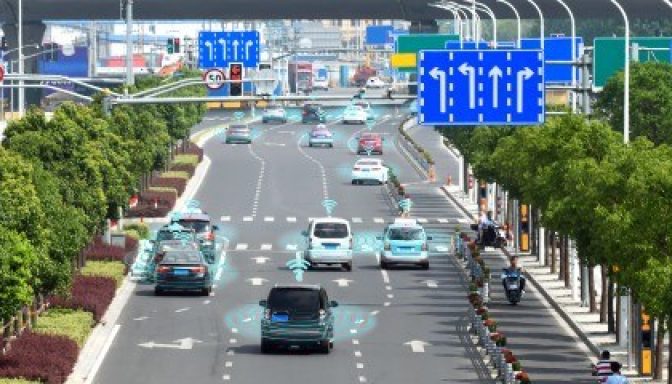The GATEway project, led by TRL and which ran from 2015 to 2018, trialled a number of different automated vehicles (AVs) with members of the public in the urban environment of the Royal Borough of Greenwich in London.
Whilst I was lead researcher for the study, one of the most common questions that I faced was that if AVs were to provide cheap, safe, reliable and convenient transportation, why would anyone choose to walk or cycle? This would run counter to efforts to encourage use of these active travel modes. The Mayor of London’s Transport Strategy (2018) highlights:
London must become a city where walking, cycling and green public transport become the most appealing and practical choices for many more journeys.
Sadiq Khan, Mayor of London, foreword to Mayor’s Transport Strategy (2018)
The UK Government has a similar outlook. The sub-heading to its Cycling and Walking Investment Strategy (2017) stated that cycling and walking should be the natural choices for shorter journeys. Further, in the foreword to its Decarbonising Transport (2020) paper, Secretary of State for Transport, Grant Shapps MP stated:
Public transport and active travel will be the natural first choice for our daily activities.
Grant Shapps MP, Secretary of State for Transport, foreword to Decarbonising Transport (2020)
There are good reasons for this emphasis. A study in The Lancet (Lee et al., 2013) estimated that the contribution of physical inactivity to the emergence and severity of conditions such as was responsible for 5.3 million deaths worldwide in 2008; more than four times the global number of deaths due to road collisions that same year.

The preferred mode for urban journeys? London cycle hire bikes docked on Concert Hall Approach
It therefore may seem counterintuitive to be developing new vehicular-based traffic modes for urban transport. However, working alongside the enlightened thinkers at DG Cities, I always saw the potential for AVs more optimistically.
Firstly, in terms of improving accessibility of transport, although walking and cycling are entirely possible for many disabled and non-disabled travellers in all but the very worst UK weather, they are not always possible for everyone. For some people, for some trips and in some conditions, motorised vehicular transport may be the only means by which some can access employment or educational, medical or social engagements. As part of an integrated, shared public transport service, AVs may enable new operational models that connect to more people more of the time.
Secondly, there is the compatibility of AVs with active travel modes. Unlike human drivers, the perception and actuation systems onboard an AV are designed to be sensibly cautious and continuously vigilant. They do not get distracted or intoxicated, they monitor 360 degrees around the vehicle at all times and they should be programmed to observe speed limits (and will go slower whenever necessary), to keep reliably to their lane and use turn signals appropriately. Although not essential for automation, it is also reasonable to assume that any AV being designed to undertake local transport duties is likely have a zero-emission powertrain, thereby minimising harm to local air quality. In short, these seem like motorised vehicles that would co-exist more readily with those choosing to walk or cycle.
Thirdly, and perhaps most importantly, they might help to break dependence on the private car for urban travel. If convenient AV-based services could serve needs that are not currently met by existing public transport routes, it might persuade urban dwellers that they do not need a private car. In its absence, people may then choose more active modes for local journeys rather than jumping in their own vehicle.

The author with one of the automated vehicles trialled on public roads around the London Olympic Park in the Driven project
Now, this might all seem fanciful and I accept that my view represents a positive take on the possibilities with AVs. However, it is important to set the objectives now for how we want our transport system to evolve in the light of the technologies that are emerging. Failure to do so risks perpetuation of a high carbon, car dependent road transport system that:
- has consistently killed or seriously injured more than twenty five thousand people per year in the UK for the last ten years;
- affects land-use patterns resulting in economic inequalities;
- has seen public transport services diminished;
- contributes to the health problems associated with physical inactivity and poor air quality;
- is predicted to see continued growth in vehicle numbers and congestion for the next thirty years.
AVs are not the panacea for all these challenges. Indeed, some models of implementation for AV technology could worsen these issues and it may be the end of this decade before we experience the benefit of AV technologies at scale. However, for some locations and for some applications, they can certainly advance us towards Brake’s stated aims for safe and healthy mobility. While we await their arrival, we should use this opportunity to establish what we do and don’t want from our transport system, broadly engaging with stakeholders, unafraid to challenge existing models and setting out a positive, inclusive vision for a safe, clean, efficient, ethical and equitable transport system. I believe AVs could be a useful component in such a vision.
Professor Nick Reed is an expert on the future of mobility. Nick was previously the Head of Mobility R&D at the world's largest automotive supplier and is now an independent consultant and the founder of Reed Mobility.
Professor Nick Reed
Founder of Reed Mobility


